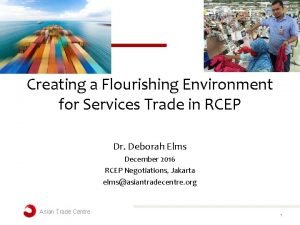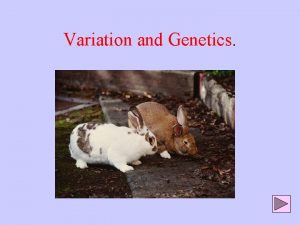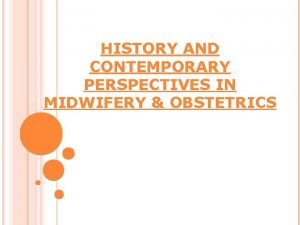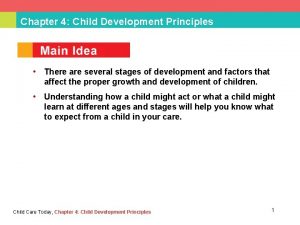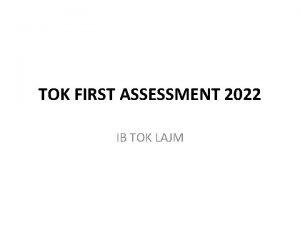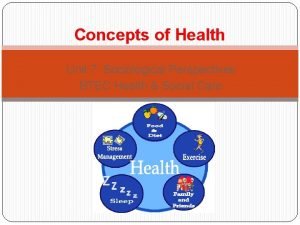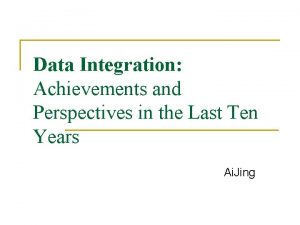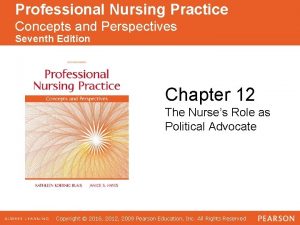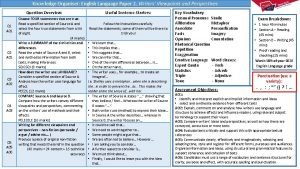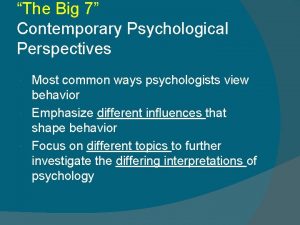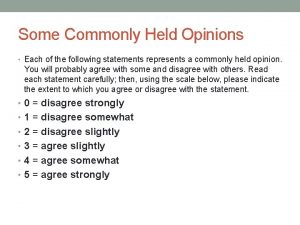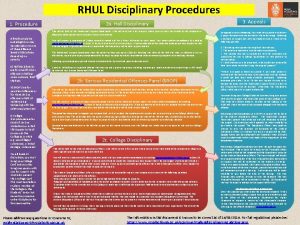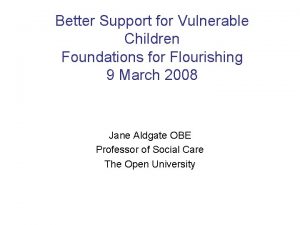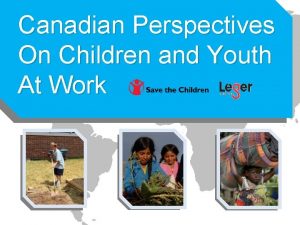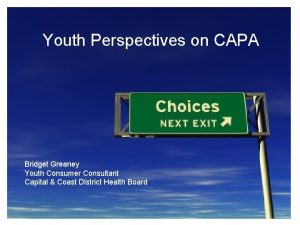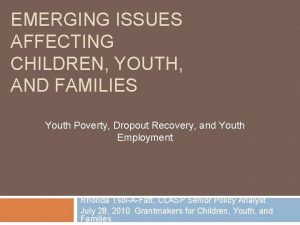CROSS DISCIPLINARY PERSPECTIVES ON FLOURISHING CHILDREN AND YOUTH























































- Slides: 55

CROSS DISCIPLINARY PERSPECTIVES ON FLOURISHING CHILDREN AND YOUTH Bonnie Leadbeater, Ph. D University of Victoria, Dec 4, 2019

WELL BEING OR FLOURISHING IS MULTIDIMENSIONAL health school work peers family

DEFINING “WELL-BEING” ANDREWS, BENARIEH, CARLSON, DAMON, DWECK, EARLS, ET AL. (2002 ) “… healthy and successful individual functioning (involving physiological, psychological and behavioural levels of organization ), positive social relationships (with family members, peers, adult caregivers, and community and societal institutions, for instance, school and faith and civic organizations), & a social ecology that provides safety ( e. g. freedom from interpersonal violence, war and crime), human and civil rights, social justice, and opportunities for participation in civil society ”

“PROTECTIVE FACTORS” OPERATE TO prevent, interrupt, or reverse risks associated with downward developmental trajectories. diminish or compensate for the causes or impact of stressful situations. reduce the negative chain reactions that characterize pathogenic family, school or community challenges. promote positive development, the maintenance of personal attributes—self-efficacy, for example—and environmental. assets, such as supportive parenting through and after divorce create beliefs or loyalties that are incompatible with health risk behaviours, and provide opportunities for positive education, vocation, personal growth and community inclusion and involvement.

STRENGTHS-BASED PERSPECTIVES “A policy that promotes strengths may also provide the most sustainable and effective approach to reducing problems. ”(Sandler 2004)

WHAT ISN’T WELL BEING/FLOURISHING Future state Basic Rights (only) Absence of problems

DIMENSIONS BY CONTEXT BY DEVELOPMENT/AGE

CHILD CENTERED ECOLOGIES DIMENS IONS Social Relation ships Individual Family & Peers Schools Community Society & Culture Capacity for positive attachments , emotional engagement Age appropriate parent supervision and monitoring Caring teacher and inclusive peer relationships Integrated systems of services for children and families Time with family (eating, vacationing, etc. ) Connected to school Opportunitie s for belonging, participating and volunteering and for civic engagement and youthfriendly work places. Protection from domestic violence School readiness Self regulation Cogniti ve Develop ment Critical thinking Problem solving Literacy Consistently close and warm family relations Open communicati on with f. Paam r ei lnyt C a l i t erriancgy a n d fl irfiee nl odnsgh i p s learning opportunitie s Valuing education Family literacy (reads to children) Family and Peer Belonging Look forward to going to school Opportunities for ethnic and cultural events Spiritual connections Drug and violence-free neighbourho od Neighbourho od cohesion Engaging Curriculum Respectful of different cultures and learning strategies Learning opportunities linked to community and practical actions Opportunities for cross cultural activities Opportunities for mastery (arts, sport, hobbies) Access to Libraries Integrated health and educational services for children (e. g. school-based immunization and health clinics) Childorientated TV programming

Material wellbeing Opportunities for work Teenagers neither employed or in school Balance of nutrition and physical activity Families living below the Low Income Cut. Off Monitoring child health and safety Protection from injury Support for families of children with chronic diseases Mortality rates Breastfeedi ng Safe habits Physica l Health Safe play spaces and activities Access to field trips Opportunities for health education/liter acy Safe playgrounds School immunizations Supervision and safety of working children Participation in sports, arts and r. Oepcpr e oa r ttui onni t i e s p r o g r f o r h eaaml tsh y activity and living Enforcement for booster seat, seatbelts, and bike helmet use Access to clean air and water Mental/ Emotion al Health Optimism Intelligence Positive selfworth Perceived security Selfregulation Freedom from anxiety and depression Conflict resolution skills Support and resources for parenting Support for children of parents with mental illnesses. Nurturing Parenting style Increasing mental health literacy – coping with stress and loss Protection from bullying Positive connections to significant non-parent adults (coaches, employers etc. ) Access to mental health support programs, therapy and interventions Access to technology, multimedia Limit advertising to children. Access to health care Chronic care services Access to medical information and care Protection from advertising of products that create health risks (smoking, alcohol, energy drinks) Regulation of water, air and e e tni toanl Dni svsi reomn im na q u a l i t y. of illness prevention programs Reduction of stigma surrounding child and parent mental illnesses

THE TASK Monitor the major, modifiable factors and conditions that are known to enhance health and well-being in young people… § MAKE GOOD CHOICES from many possibilities § Based in theories of child development § BC-BASED to support local strengths and values, inform ongoing efforts, and future directions, address disparities,

CRITERIA FOR CHOOSING INDICATORS Significant to the well-being of children: Relevant to policy Rigorous methods for assessment Positive and negative dimensions of children’s lives Gives consideration to well–being and well–becoming Capable of Producing Estimates for Key Subgroups Readily understood by multiple stakeholders Common interpretation and comparability Forward-looking

WHAT DO WE WANT OUR CHILDREN’S WELL BEING TO LOOK LIKE?

A RESEARCH EXAMPLE: INDICATORS OF WELL BEING IN THE TRANSITIONING FROM ADOLESCENCE TO YOUNG ADULTHOOD Richard Stanwick Murray Fyfe & Bonnie Leadbeater

WHY FOCUS ON YOUNG ADULTHOOD Developmental tasks of this young adulthood include building capacity for financial and residential independence, as well as establishing long-lasting sources of social support. However, there is increasing diversity in the timing and the success with which young adults achieve these fundamental social determinants of health.

IDENTIFIED A SAMPLE OF YOUTH FROM GREATER VICTORIA REGION Youth recruited in 2003 using random digit dialing of 9, 500 private telephone listings. 1036 eligible households were identified (had youth aged 12 -18 years old) 662 adolescents & their parents (64%) agreed to participate.

PARTICIPANTS INTERVIEWED ACROSS 10 YEARS Time 1 Time 2 Time 3 Time 4 Time 5 Time 6 2003 2005 2007 2009 2011 2013 • N = 539 (81%) • N = 459 (70%) N = 463 (70%) N = 477 (72%) • N = 662 • N = 578 (87%) 48% males 47% males 45% males 44% males 46% males 45% males 12 to 18 years 14 to 20 years 16 to 22 years 18 to 24 years 20 to 26 years 22 to 28 years

INTERVIEWS Data were collected biannually over ten years in individual face-to-face interviews in youths’ homes by trained research assistants. Privacy was provided for sensitive questions (e. g. mental health, sexuality, substance use, aggression)

DIMENSIONS ASSESSED 1) physical health (BMI, sleep, B/P, STIs and injuries; 2) workplace stress & mental illness; 3) health risk behaviours (alcohol and marijuana use, seatbelt use, drinking and driving); 4) dating aggression; 5) parent and peer support; 6) social determinants of health (accrued educational, occupational and economic capital, employment and 7) well-being (purpose in life, autonomy, quality of relationships).

ECONOMIC WELL-BEING Social Determinants of Health

WAGE Average Wage 2013 $26, 90 2011 2009 $14, 50 $9, 30 $0, 00 $5, 00 $10, 00 $15, 00 $20, 00 $25, 00 $30, 00

AVERAGE DEBT $25 000 $22 071 $20 000 $18 879 $17 547 $14 957 $15 000 2011 2013 $10 000 $5 000 $2 905 $2 857 $0 Credit Card Student Loan Line of Credit

FINANCIAL STRAIN (2013) Economic disparities limit youth’s opportunities to engage in a healthy lifestyle. 23% of young adults say they have trouble paying for basic living expenses. 58% of young adults had trouble paying for “things they enjoy”.

ECONOMIC CONCERNS LEAD STRESSORS

MENTAL HEALTH

EMOTIONAL PROBLEMS Symptoms of Depression & Anxiety Rise across Adolescence & Begin to Decline by Age 23

DECLINING BEHAVIOURAL PROBLEMS Oppositional Defiant (ODD) & Attention-Deficit/Hyperactivity (ADHD) ODD symptoms affect educational achievement & job strains in 2013 (Leadbeater & Ames, in preparation)

PSYCHOPATHOLOGY PERSISTS ACROSS THE TRANSITION TO YOUNG ADULTHOOD. Youth who start high in one domain are consistently high in the others. Increases in depression & anxiety are correlated. Increases in depression & oppositional defiant symptoms are correlated. Leadbeater, Thompson, & Gruppuso, 2012

WELL-BEING 28

EMOTIONAL SUPPORT & WELL-BEING 29

VOLUNTEERING 100 In the past 12 months, did you volunteer without being paid. . . Percentage of Youth 90 80 For Neightbours/Relatives 70 For a Cause 60 To Fund Raise 50 40 In Your Community 30 At School 20 Other 10 0 2003 2005 2007 2009 2011 2013 Wave 30

NEIGHBOURHOOD CONNECTEDNESS 31

YOUNG ADULT BEHAVIOURS

TANNING DECLINED FOR THE COHORT

ALCOHOL USE 14 2005 82 16 20 2007 93 24 18 2009 96 30 15 2011 96 30 14 2013 33 0 20 40 60 80 Percent of Young Adults 96 100 Heavy Episodic Drinking (drank 5+ drinks more than once a week) Any Alcohol Use in the Past Year Felt the Need to Cut Down on Drinking

ALCOHOL & DRIVERS & PASSENGERS (2013)

SUBSTANCE USE IN LAST YEAR



SEXUAL HEALTH (2013) Sexual Activity 50% have had 9 or more sexual partners in their lives (average 2 per year) 69% always use some form of contraception. BUT ONLY 24% use condoms always Sexually Transmitted Infections 22% have had an STI in their lives (accumulated data) 8% had received treatment within the last 12 months 16% of females & 7% of males have been immunized for HPV

CONDOM & CONTRACEPTIVE USE 70% 68% 60% 50% 49% 47% 52% 40% 36% 45% 35% 27% 30% 33% 20% MALE FEMALE 25% 22% 2011 2013 10% 0% 2003 2005 2007 2009 Always Used Condoms 100% 95% 90% 85% 82% 84% 81% 83% 80% 75% 70% 71% MALE 70% 65% 73% 61% 2009 2011 63% 60% 55% 52% 50% 2003 2005 2007 Always Used Birth Control 2013 FEMALE

PHYSICAL HEALTH

INCREASING BODY MASS INDEX 2013 based on measured weight and height 17% overweight (25 kg/m 2 to 30 kg/m 2 ) 10% obese (>30 kg/m 2 )

HYPERTENSION (SITTING B/P IN 2013) 18% of young adults have Stage 1 Hypertension ( 140/90 ). 4% have Stage 2 Hypertension (160/100) Young adults with hypertension are 3 times more likely to be male

PHYSICAL & MENTAL HEALTH SYMPTOMS …had symptoms every week or more. 35% 29% Participant Percentage 30% 29% Headache 25% 20% 15% 21% 20% 13% Feeling Low Irritable Nervous 6% 0% Backache Dizziness 10% 5% Abdominal Pain Sleeping Difficulties

HEALTHY LIFE STYLE BEHAVIORS

SLEEP DURATION DECLINES WITH AGE 30% do not get the 7 hours of sleep recommended by the National Sleep Foundation. 40% report waking up in the morning and still feel tired regardless of hours slept.

SLEEP DURATION MATTERS Shorter sleep duration is related to higher BMI and to more depression and anxiety in adolescent girls (Ames, Holfeld, & Leadbeater, 2015). How can we support the value of sleep?

NUTRITION CHOICES ARE GOOD

PHYSICAL ACTIVITY IN AN AVERAGE WEEK DECLINES exercise 3 -4 times (e. g. , running, swimming, other sports). exercise vigorously for 20 -30 minutes at least 3 times participate in a regular program of sports/exercise

MOTIVATION FOR EXERCISE IS HIGH § 81% wished they were in better physical condition. § 38% are not proud of their body. § More than 50% are dissatisfied with their muscle tone and weight. Dissatisfaction with Specific Aspects of their Bodies

HEALTH SERVICES UTILIZATION

PHYSICIAN VISITS 78% of young adults visited a doctor in the past year.

HEALTH SERVICE UTILIZATION 70% 66% % of young adults that used Participant Percentage 60% these services in the past year. 50% 40% 30% 26% 21% 20% 16% 14% 10% 6% 1% 0% Dentist Optometrist Surgeon Chiropractor Physiotherapist Social Worker Psychologist Speech Therapist

YOUR GOALS AND WHAT YOU ARE DOING IS IMPORTANT TO MONITOR! Selecting indicators § What is important to continue to monitor? § What variables can we select that fit with interests and priorities of the Island Health Authority § What can be acted on?

THOUGHTS? QUESTIONS? COMMENTS? Contact: Bonnie Leadbeater bleadbea@uvic. ca
 Stress health and human flourishing
Stress health and human flourishing Reflexivity definition
Reflexivity definition Disciplinary record higher pe
Disciplinary record higher pe Disciplinary knowledge
Disciplinary knowledge Powerful disciplinary knowledge
Powerful disciplinary knowledge Disciplinary literacy in physical education
Disciplinary literacy in physical education Capa-cs collaborative agreement
Capa-cs collaborative agreement Frisk discipline
Frisk discipline Ut arlington library
Ut arlington library Florida children and youth cabinet
Florida children and youth cabinet Flourishing under fire examples
Flourishing under fire examples Human flourishing nursing examples
Human flourishing nursing examples What is humanities
What is humanities When did the sea roads start
When did the sea roads start By about what year were greek city-states flourishing
By about what year were greek city-states flourishing Flourishing environment
Flourishing environment Red cross youth services
Red cross youth services National youth council red cross
National youth council red cross Test cross and back cross
Test cross and back cross Test cross and back cross with example
Test cross and back cross with example Example of incomplete dominance
Example of incomplete dominance What is the difference between monohybrid and dihybrid
What is the difference between monohybrid and dihybrid In the cross, in the cross be my glory ever
In the cross, in the cross be my glory ever Anti monson curve
Anti monson curve Differences between structural and action perspectives
Differences between structural and action perspectives Health promotion in nursing practice 7th edition
Health promotion in nursing practice 7th edition Historical perspective of midwifery
Historical perspective of midwifery Child development principles and perspectives
Child development principles and perspectives Tok essay titles 2022
Tok essay titles 2022 Examples of perspective of anthropology
Examples of perspective of anthropology Unit 10 sociological perspectives
Unit 10 sociological perspectives Perspective and methodology of economics
Perspective and methodology of economics The social and ethical perspectives of entrepreneurship
The social and ethical perspectives of entrepreneurship Data integration problems approaches and perspectives
Data integration problems approaches and perspectives Personological and life story perspectives
Personological and life story perspectives Gregor andrade
Gregor andrade Define family matters
Define family matters Writers viewpoints and perspectives
Writers viewpoints and perspectives Political astuteness in nursing
Political astuteness in nursing Paper 2 writers’ viewpoints and perspectives
Paper 2 writers’ viewpoints and perspectives Perspectives on appeasement interactive notebook
Perspectives on appeasement interactive notebook Strategy as a perspective
Strategy as a perspective Sociological imagination
Sociological imagination Three theoretical perspectives in sociology
Three theoretical perspectives in sociology Theoretical perspectives on the family
Theoretical perspectives on the family Four theoretical perspectives
Four theoretical perspectives The six personal perspectives
The six personal perspectives 7 contemporary psychological perspectives
7 contemporary psychological perspectives Hand mnemonic for the 7 perspectives of psychology
Hand mnemonic for the 7 perspectives of psychology Poems with two perspectives
Poems with two perspectives Experientalist
Experientalist Three major theoretical perspectives in sociology
Three major theoretical perspectives in sociology Psychology 7 perspectives
Psychology 7 perspectives Perspectives in health information management
Perspectives in health information management Global perspective research questions
Global perspective research questions 7 contemporary perspectives of psychology
7 contemporary perspectives of psychology















